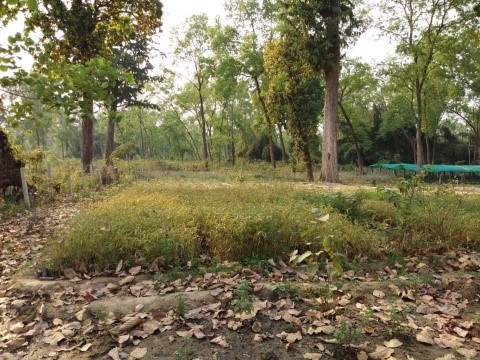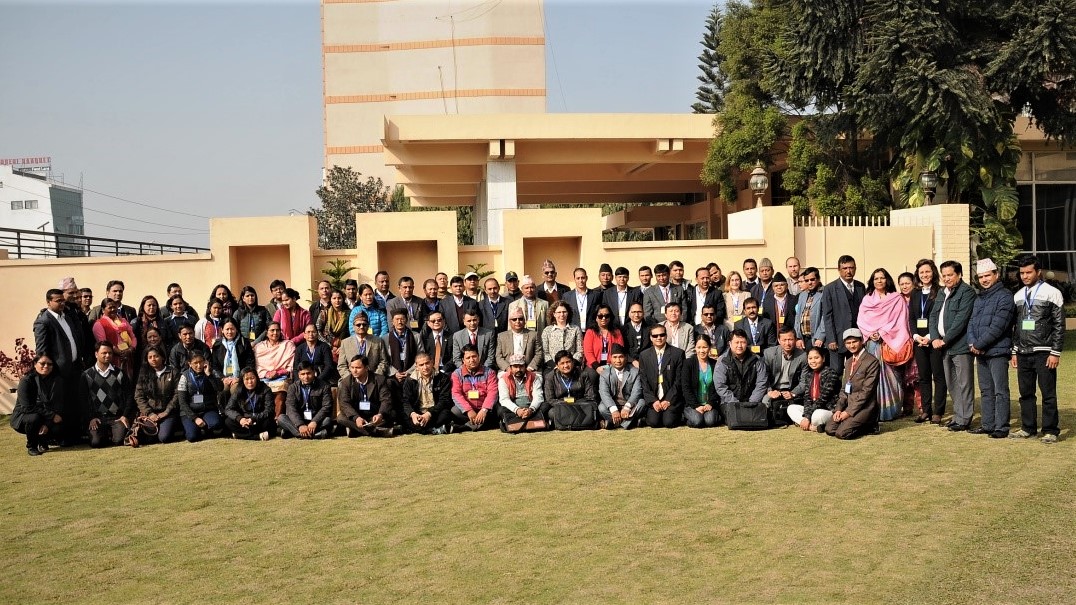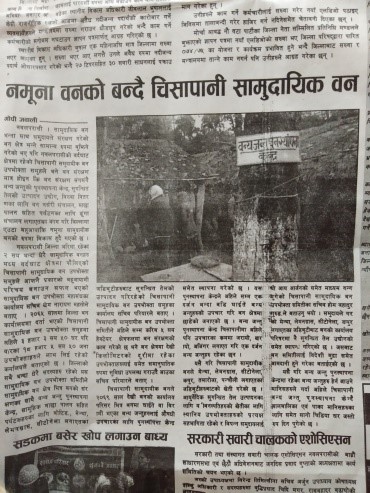Community Initiation for Scientific Forest Management
The Chisapani CFUG in Nawalparasi was handed over as CF in 2004. During the handover, the area of the forest was 160 hectaresbut in 2016, an additional 337 hectares of forest was added and handed over to the same user group. It is one of the largest community forests with high number of users in Nepal. There are about 3,500 households who are residing up to 18 kilometers away from the community forest. The forest managed by Chisapani CFUG is dominated by the Shorea robusta and riverine species. Illicit cuttings, smugglings, and encroachment of forested land were some of the major problems faced by the CFUG when 160 hectares of forest was first handed over in 2004. Initially, forest conservation and people participation were the major areas of focus of the CFUG’s Constitution and Operational Plan. This CFUG is adjoining to the national forest and used to be safe buffer zone for many wild animals. In 2006, another 337 hectares of national forest was added in this CF. Along with the area, the number of users also increased.
This CFUG has initiated scientific forest management (SFM) practices in the plain 160 hectares that have been divided into 80 blocks. This SFM was aimed at sustainable timber production and economic benefits including the social cultural and environmental values (FAO 2016). The history of SFM in Nepal is very short and this CFUG is one of first to adapt and apply the SFM in community forest.

In 1990, the Government of Nepal attempted SFM in Bara district but could not succeed. Re-piloting of SFM was done in 2013 in a Shorea robusta forest in the Kapilvastu district. This time, however, the piloting was a success and inspired the Nepalese foresters, users and CFUG leaders to replicate SFM in other CFs all over the country. In Nepal, SFM is regarded as a potential option for improving depleting forest quality and productivity, and for harnessing the true economic potential of forest resources (MSFP 2015). In this CFUG, the SFM operation is carried out in one block every year. In each block, 30-33 trees have been selected as “mother trees” and 51-52 trees are selected to be cut down. Natural regeneration as well as plantation are promoted in the cleared spaces. This operation has been helping to improve the forest condition as well as create varied income generation opportunities. The DFO has approved the SFM Operational Plan of Chisapani CFUG for 80 years.
The District Forest Officer of the Nawalparasi district opined, “The intentions of SFM are to increase the maximum benefits from the forest. SFM is the only means of increasing the benefits from the forest through optimal forest resource allocation and use.”
The forest managed by Chisapani CFUG is dominated by the Shorea robusta and riverine species. Illicit cuttings, smugglings, and encroachment of forested land were some of the major problems faced by the CFUG when 160 hectares of forest was first handed over in 2004. Inititally, forest conservation and people participation were the major areas of focus of the CFUG’s Constitution and Operational Plan. This CFUG is adjoining to the national forest and used to be safe buffer zone for many wild animals. In 2006, another 337 hectares of national forest was added in this CF. Along with the area, the number of users also increased.
Mr. Hom Bahadur Gurung, a resident of Bardghat Municipality joined Chisapani CFUG in 2005 in the capacity of a Secretary. Before that, he used to work in Saudi Arabia as a migrant labor. He compared his village’s context with that of Saudi Arabia and found incredible potential to promote greenery, water sources, and fauna and flora inside the forest. The abundant resources inspired him to work with and in the CFUG. He attended every monthly meeting and annual general assembly meeting. He had been keeping regular contact with the DFO and other I/NGOs and learn about new ideas about how to develop and evolve the CFUG. He and other members of the CFUG participated in forest management, group management, leadership development, and Gender Equality and Social Inclusion (GESI) trainings conducted by the DFO, and I/NGOs such as Resource Identification and Management Society (RIMS), Leasehold Forestry Programme (LFP), Multi Stakeholder Forestry Programme (MSFP), and Wildlife Conservation Nepal (WCN).
In 2009 Mr. Gurung had the opportunity to participate in Master ToT of REDD+, climate change mitigation and adaptation jointly conducted by RECOFTC, WWF, and Winrock in Palpa district.
According to Mr. Gurung, this training helped him to understand about the services provided by a CFUG to an individual's daily life. That training also helped to gain a broader understanding about forest and climate change. Since the Master ToT was designed as a cascading model, Mr. Gurung conducted an orientation training in his CFUG after being trained. The orientation training initiated new discussion about the forest services and quality of forest within CFUG and became the agenda of rigorous discussions in the following monthly meetings. Moreover, the users of the CFUG were feeling the impacts of climate change as the rainfall and precipitation cycle were becoming more and more haphazard. Hence, the orientation on such burning issues caught the attention of all the users, he recollects. He conducted several talk programs and training sessions to school students, teachers and neighboring CFUGs as well as campus students.

Jan Udaya CFUG (Kirtipur Nawalparasi), Hariyali CFUG (Bardhaghat), Parijat CFUG (Bardhaghat), and Bisasaya CFUG (Sunaul) have also organized REDD+ and climate change mitigation and adaptation orientation trainings using their own funds and invited Mr. Hom Gurung as the RP. After that training, these CFUGs have incorporated REDD+ issues in their constitutions and Operational Plan and have also designed activities for adaptation and mitigation said Mr. Surya Bahadur Chand, the President of Jan Udaya CFUG. He further stressed that they also have plans to protect their wetlands and build a water harvesting pond.
The DFO has conducted forest management training and helping CFUG to operate the management practices inside the CF. Wildlife Conservation Nepal (WCN) has been supporting for improved cooking stoves and bio gas plant to the users of Chisapani CFUG. The members of above mentioned CFUGs have been applying the adaption measures in their farm land as well. They have been using drip irrigation system, improved cooking stoves and installing the bio gas plant. They are also applying the agro forestry system in their farm land. In Shankarapur village 178 households have been using water storage tank to protect the drinking water during the flooding seasons.
Changes in Policies and Practices
In Nawalparasi district, the CFUGs have been incorporating REDD+ and climate change adaptation and mitigation-focused programs and activities in their Constitution and Operational Plan. The CFUGs have defined forest services in these official documents. REDD+ training has helped to introduce forest services as the new areas to accrue benefits for the CFUG members. Because of this, Jana Udaya CFUG, Chisapani CFUG, Sansarbot Hariyali CFUG, Parijat CFUG and Bisasaya CFUG have been developing Operational Plans based on REDD+ and climate change adaptation and mitigation strategies. They have been protecting the wetlands inside their respective CFUGs and developing a plan to construct a water harvesting pond as well. The CFUGs have developed a strong linkage with the rural municipality and municipality to address issues surrounding REDD+ and climate change mitigation and adaptation at the local level. There are stories published about the CFUGs’ work in national newspaper dailies as given in the example. The story, which was published on 14th July, 2014, highlights how the Chisapani CFUG has been working as a demonstration site and a source of inspiration for many other forest groups on REDD+ in the region.
Improving Leadership and Institutional Capacities of CFUGs
The regular meetings, interactions and capacity building programs have been helping CFUG members to develop their leadership capacities as well. The CFUG members have been leading numerous community-based organizations, cooperatives, school management committees and local government as claimed by Mr. Hom Gurung. A total of 29 CFUG members have been elected in various positions of the local government in Nawalparasi.

Chisapani CFUG has its own office building. This CFUG has fixed 2nd day of every month as the day to hold monthly meetings. Every decision is taken during the monthly meeting. Monthly progress and following month’s plan are also reviewed during the monthly meetings. All users are aware about the CFUG’s activities and the CFUG’s account has been kept in a double entry system to ensure accountability. The annual general assembly meeting takes place once in a year. This meeting approves the financial and program progress reports and following the years’ plan, also the policies and the budget. The CFUG invites the DFO, NGOs, and local government representatives in their annual general assembly.
Through the technical support from the DFO, the Chisapani CF users are aware about REDD+ and how to develop the SFM plan based on REDD+. This CFUG has been protecting the wetlands and developing water harvesting pond alongside the Mahendra highway. This pond has been supplying water during dry season for wild birds and animals, cattle and even the fire brigade. The CFUG has adopted a regular routine of silviculture operation inside the CFUG as a part of its SFM technique. The users are more concerned about the quality of the forest and climate change adaptation and mitigation activities today than ever. They have established a nursery and regularly carry out plantation in CF as well as private land.
The Chisapani CFUG has built a strong linkage with the local government, government line agencies, Department of Forest, Winrock international, WCN, International Development Enterprises (IDE), WWF, and FECOFUN as these organization representatives participated in the CFUG’s general assemblies and also invited the CFUG members in capacity development programs. It has been receiving various kinds of support including capacity development, improved cooking stoves, and bio-gas to the CFUG members from these organizations. Chisapani CFUG also has a good linkage with the local youth clubs, schools and colleges.
(Opinion, thoughts and learning shared in this report is based on Mr. Tamang's experience in working in forestry sector for more than a decade)

